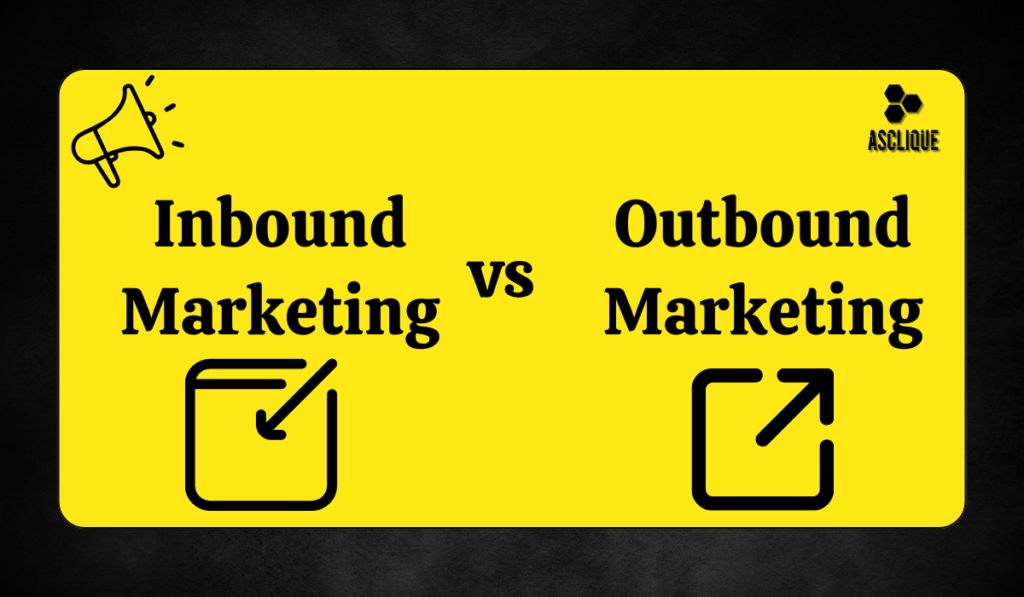In this constantly evolving world of marketing, two have become the predominant ways to gather customers: outbound and inbound marketing. Both strategies have significant variances that businesses wishing to utilize their marketing efforts efficiently must be aware of, as each has distinct advantages and disadvantages of its own. In an attempt to assist companies in better understanding this changing battlefield, we look at the key variations, advantages, and tactics between inbound and outbound marketing.
What is Inbound Marketing?
Inbound marketing is a customer-focused strategy that attracts individuals through valuable content and engaging experiences.. Rather than ‘yelling’ products or services at people, it pulls them in because it is listening to and paying attention to what the market needs and wants. Primarily, this requires producing content that drives quality engagement and gets the target audience to seek out your business.

Example:
- A travel agency can come up with travel blog articles about the best vacation spot and what tips tourists should expect for a trip.
- A skincare brand can produce how-to videos on proper application of product. These are always likely to attract viewers who are curious about routine skincare.
Key Elements of Inbound Marketing
Content creation: The fundamental component of inbound marketing, good content is created in the form of blog posts, eBooks, videos, podcasts, or infographics. All the content is created to answer questions, to solve problems, and provide insights that resonate with the target audience.
Search Engine Optimization: SEO means getting the content in front of the right audience, which is bringing business visibility in the search results and organic traffic. Inbound marketing drives the creation of social media. Social media marketing focuses on building relationships, raising brand awareness, and driving traffic by sharing valuable content and engaging with followers.
Email marketing: Inbound marketing can adopt targeted email campaigns that nurture leads to continue relations with the client. Through this, businesses can guide prospects through their buying journey in relation to the most significant content and offers available.
Nurturing Leads: Inbound marketing focuses on cultivating and fostering leads gradually over time. Businesses can, indeed, foster trust and drive prospects’ conversion by using relevant and meaningful content and information that relate to prospect interests and behavior.
Benefits of Inbound Marketing
- Cost-Effective: Compared to traditional outbound types of marketing, inbound marketing usually requires much less investment. When a business creates valuable content, it attracts and retains customers with little need for high advertising costs.
- Builds Trust and Credibility: Through content providing valuable insights based on the answers to customer pain points, a business can establish itself as an authority in its field, thereby gaining the trust and credibility of its audience.
- Long-term Leads: Marketing through inbound can offer long-term leads. Once quality content goes live, it continues to attract visitors and leads, making this a sustainable form of marketing.
- Audience Engagement: Inbound marketing allows better engagement of the targeting audience, thereby increasing chances of attracting and converting more qualified leads.
What is Outbound Marketing?
Outbound marketing is a relatively traditional approach of pushing product or service out to consumers. This method encompasses a whole range of marketing tactics that are designed to hit a wide audience of potential customers often interrupting their daily activities for delivering promotional messages. Outbound marketing solely relies on direct outreach and advertising for leads as well as sales.

Example;
- A company might run a TV commercial during a popular show to promote its new snack.
- A local pizza parlor might include a few menus and flyers in mailboxes as a means of advertising their delivery service.
Outbound Marketing- Key Elements
Television and Radio Advertising: Traditional types of media, of course, are the television and radio. They have been used for ages for outbound marketing purposes. The advertisements are broadcasted to a mass audience, hopefully creating brand awareness and interest.
Print Advertising: This comprises newspapers, magazines, brochures, and leaflets. The objective of such prints is to attract the customer’s attention and pass along the promotional message.
Cold Calling: Direct selling approaches, that is, cold calling, by the salesperson, contacting potential customers without any previous contact, pitching the product/services over the phone.
Email Marketing Blast: While outbound marketing typically sends unwanted email blasts to promote goods or services, email marketing can also support inbound efforts.
Event Sponsorships and Trade Shows: By either sponsoring events or taking part in the events, the organizations use another outbound marketing technique. The businesses show their products or services to a captivated audience, hoping to obtain some leads and good brand awareness.
Benefits of Outbound Marketing
- Quick results: Outbound marketing can result in quick results for businesses, which are related to leads or sales generation so it is ideal for businesses that require leads or sales shortly.
- Wide Reach: Outbound marketing helps businesses reach a wide audience, including those unaware of the brand or its offerings.
- Brand Awareness: Through repeated exposure to ads through various media channels, outbound marketing helps to establish brand recognition.
- Applicability in New Products: For new products or services coming into the market, the different types of outbound marketing would create potential buzz and will generate interest among the target consumers.
Inbound vs Outbound Marketing: Key Differences
Understanding the distinctions between inbound and outbound marketing is crucial for businesses aiming to develop effective marketing strategies. Here’s a table summarizing the aspects of inbound and outbound marketing based on the provided data:
| Aspect | Inbound Marketing | Outbound Marketing |
| Engagement Strategy | Focuses on bringing the customer through high-value content and experiences. It tries to attract potential customers by appealing to their needs and interests.
Example: A blog post that talks about advice on home gardening. |
Focuses on thrusting promotional messages into consumers, generally interrupting their daily activities to deliver advertisements.
Example: A flier for a new pizza shop that comes door-to-door. |
| Content Strategy | Uses a significant amount of content creation, SEO, and social media engagement to attract organic traffic and customers.
Example: A how-to video on cooking pasta on social media. |
Utilizes traditional advertising tools like TV, radio, print, and cold calling to reach large audiences quickly.
Example: An advertisement for a car airing during a major sports event. |
| Lead Generation | Focuses on nurturing leads with personalized content and engagement campaigns, moving them along the sales funnel.
Example: A free e-guide on budgeting to download in exchange for an email address. |
Primarily aimed at generating leads and sales immediately through direct outreach and advertising efforts.
Example: A sales rep calling people to offer a discount on cable. |
| Cost Efficiency | Generally more economical over the long term because it relies on organic traffic and good content rather than pricey advertising.
Example: A high-quality blog post that continues attracting visitors without extra cost. |
Tends to require a lot of spending in advertising and outreach, which may result in a higher cost per lead or sale.
Example: Expenses for a billboard promoting a local event. |
| Long-term vs. Short-term Outcomes | Delivers long-lasting results through high-quality content that continues attracting traffic for years.
Example: A very popular recipe blog that attracts visitors for years. |
Usually gives quick results, but the impact likely diminishes drastically once the advertisements stop.
Example: A sale event that brings in customers but has no lasting effect after the sale period. |
Integrating Inbound and Outbound Marketing
Inbound and Outbound marketing can be regarded as opposite strategies, but their combination in one system could be well-suited to business needs. So, let’s see how this can be done:
- Leveraging Content for Outbound Efforts: Business managers can use the creative content from inbound marketing for outbound marketing too. Instead of sending regular email blasts, they can share helpful articles or videos that provide value and increase engagement.
- Using Outbound to Drive Inbound Traffic: Outbound marketing techniques can be applied to make people come to an inbound content. A company can promote its blog posts or downloadable resources via social ads or print media so that people visit the website.
- Retargeting Strategies: With the help of retargeting ads, companies can meet people who have recently interacted with a brand through inbound channels. This technique combines both outbound advertising and inbound engagement; this would ensure maximum conversion results.
- Testing and Optimization: By monitoring the performance of the in-bound and out-bound marketing efforts, the company will have the real time data for optimization. This process is constantly repeated so that the organization can identify the effective strategies meant for their targeted audience..
Conclusion
Today in the marketing world, both inbound and outbound models are equally essential to engage and win customers. Inbound marketing creates value to attract a target audience, while outbound marketing pushes messages to a wider audience. This comparison aids businesses in choosing a marketing strategy that maximizes return on investment by highlighting the strengths and weaknesses of both approaches. By merging outbound’s quick results with inbound’s long-term benefits, companies can drive growth.

